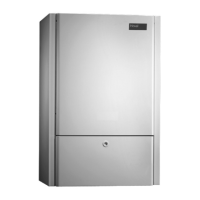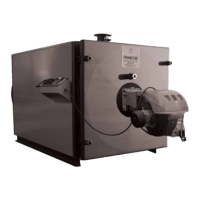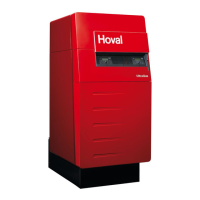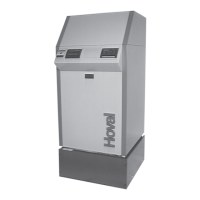294 214 283 / 00
INSTALLATION
4.8 Minimum value limiting of boiler return
temperature
Hydraulic and technical control measures are to be imple-
mented to ensure that the minimum boiler feed and return
temperatures are not fallen below.
4.9 Setting the temperature controller
Boiler temperature controller, selectable TR 65-85°C
The basic setting is made by the heating installer. Selec-
tion and setting of the different heating programs accor-
ding to operating instructions.
4.10 Boiler safety valve
Heating installations and hot water supply systems are to
be protected against inadmissible overpressure by safety
valves. The blow-off pressure of the heating system safe-
ty valve must correspond to the maximum rated thermal
it's downstream isolating valve.
4.11 Filling pump
(boiler with separate calorifier)
Speed and output regulation must correspond to the re-
made by the heating specialist.
4.12 Heating pump
Speed and output regulation must correspond to the re-
made by the heating specialist.
4.13 Heating connections
In the case of boiler installation in the domestic domain,
-
xible compensators.
4.14 Installing a flue gas thermometer (optional
item)
A 3/8” sleeve with a max. length of 25 mm is to be welded
control panel; see Fig. 22.
capillary through the rear wall between the external and
round insulation.
Screw the sensor tube into the sleeve.
STB
Flue gas
temperature sensor
Fig. 22
The capillary must not be kinked.
Important note:
routed on the top, along the boiler insulating mat,
towards the back.
4.15 Gas Boosters
A booster is required when the gas pressure at the burner
Important
If a critical system is served it is good pra-
ctise to install a duty/standby gas booster
Gas Regulations require that no more than 0.5" WG pres-
sure is lost due to pipe work resistance between the sup-
ply meter and the gas inlet.
4.15.1 Booster Installation
It is usually preferably to locate the boosters as near as
possible to the burner served rather than close to the me-
ter.
• Leave adequate access for servicing drive belts, fan
bearing assemblies, electrical motors and any acoustic
shroud.
• Ensure that the room in which the gas booster is to be
installed is well ventilated and free from dust.
set.

